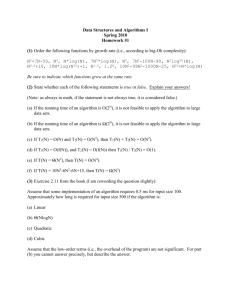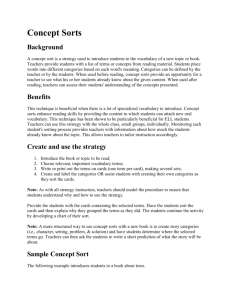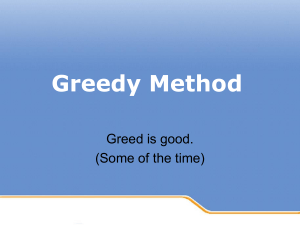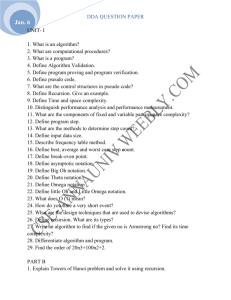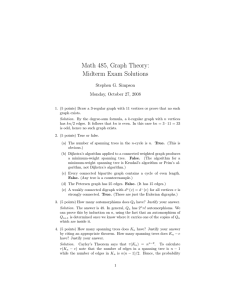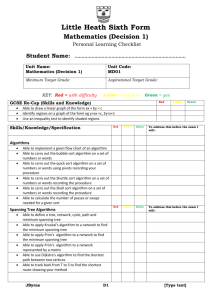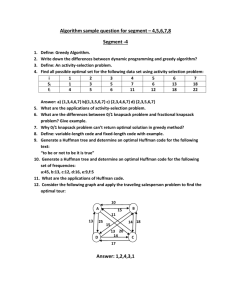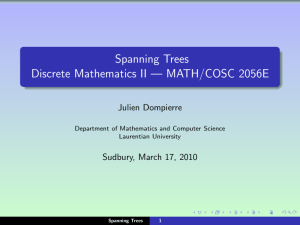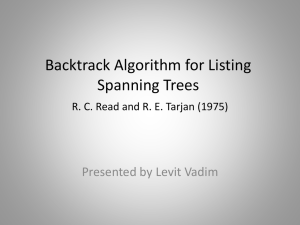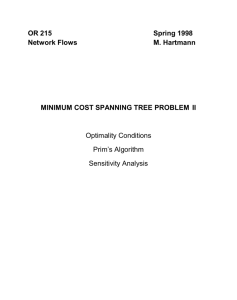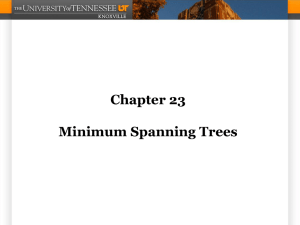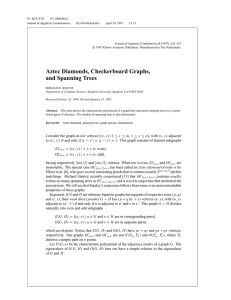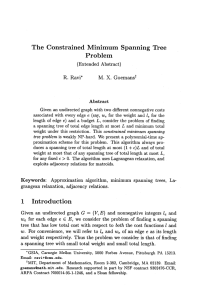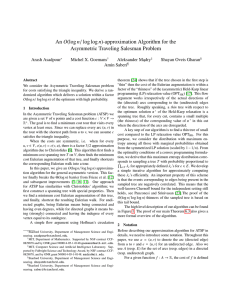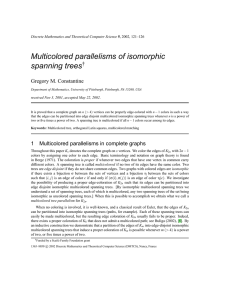DAA Assignment Questions - Farah Institute of Technology
advertisement
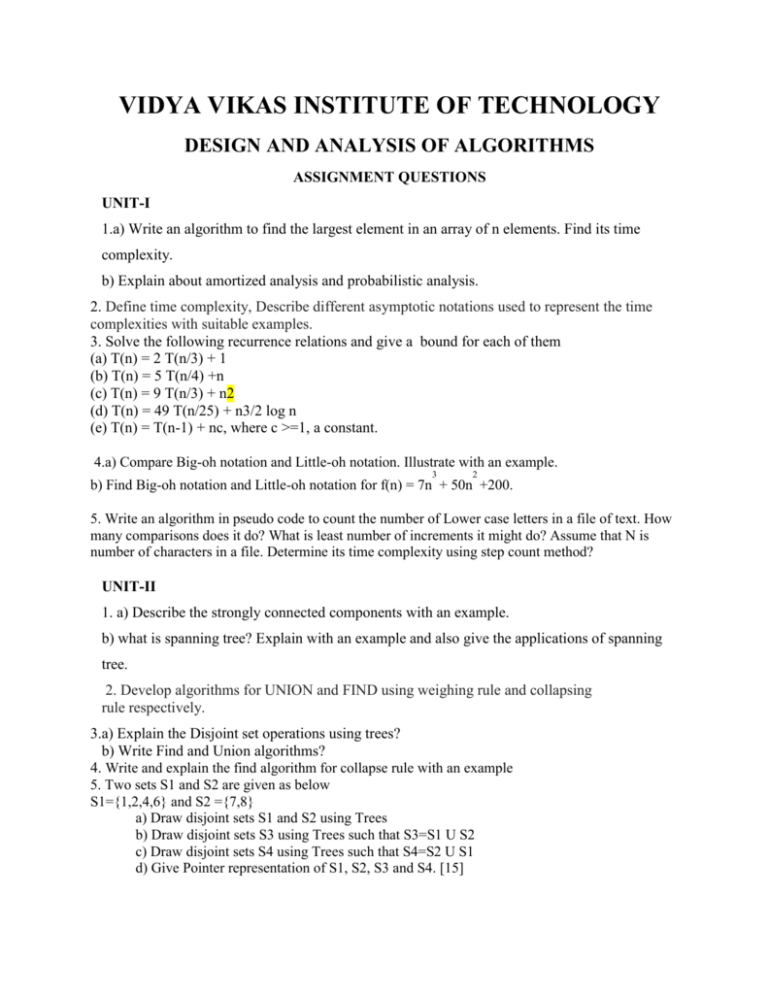
VIDYA VIKAS INSTITUTE OF TECHNOLOGY
DESIGN AND ANALYSIS OF ALGORITHMS
ASSIGNMENT QUESTIONS
UNIT-I
1.a) Write an algorithm to find the largest element in an array of n elements. Find its time
complexity.
b) Explain about amortized analysis and probabilistic analysis.
2. Define time complexity, Describe different asymptotic notations used to represent the time
complexities with suitable examples.
3. Solve the following recurrence relations and give a bound for each of them
(a) T(n) = 2 T(n/3) + 1
(b) T(n) = 5 T(n/4) +n
(c) T(n) = 9 T(n/3) + n2
(d) T(n) = 49 T(n/25) + n3/2 log n
(e) T(n) = T(n-1) + nc, where c >=1, a constant.
4.a) Compare Big-oh notation and Little-oh notation. Illustrate with an example.
3
2
b) Find Big-oh notation and Little-oh notation for f(n) = 7n + 50n +200.
5. Write an algorithm in pseudo code to count the number of Lower case letters in a file of text. How
many comparisons does it do? What is least number of increments it might do? Assume that N is
number of characters in a file. Determine its time complexity using step count method?
UNIT-II
1. a) Describe the strongly connected components with an example.
b) what is spanning tree? Explain with an example and also give the applications of spanning
tree.
2. Develop algorithms for UNION and FIND using weighing rule and collapsing
rule respectively.
3.a) Explain the Disjoint set operations using trees?
b) Write Find and Union algorithms?
4. Write and explain the find algorithm for collapse rule with an example
5. Two sets S1 and S2 are given as below
S1={1,2,4,6} and S2 ={7,8}
a) Draw disjoint sets S1 and S2 using Trees
b) Draw disjoint sets S3 using Trees such that S3=S1 U S2
c) Draw disjoint sets S4 using Trees such that S4=S2 U S1
d) Give Pointer representation of S1, S2, S3 and S4. [15]
UNIT-III
1 a) Derive the time complexity of the Quick sort in an average case.
b) compare and contrast divide and conquer approach and greedy approach.
2. a) Write and explain the control abstraction for Divide and conquer and give the time
complexity.
b) Discuss Strassen’s matrix multiplication and derive the time complexity.
3.a) Show how Merge sort sorts the following sequences of keys in ascending order. 12, 22, 33,
44, 48, 56, 57, 65, 76, 84 with a neat diagram representing sequence of recursion calls?
b) Discuss the time complexity of Merge sort?
4.a) Show how quick sort sorts the following sequences of keys in ascending order. 12, 25, 35,
43, 48, 59, 77, 85, 86, 94?
b) Discuss the time complexity of the quick sort algorithm for the above case?
5. a)what is Binary search? explain with exmples.
b)Write an algorithm for recursive binary search?
UNIT-IV
1 a) Solve the following by using job sequencing with deadlines.
n=5, (p1,....,p5)=(20,15,10,5,1) and (d1,......,d5)=(2,2,1,3,3).
b) Write an algorithm of kruskal's minimum cost spanning tree.
2.a) What is the solution generated by the function Job sequencing when N=7,
(P1, P2, … …P7) = (3, 5, 20, 18, 1, 6, 30) and (d1, d2, … d7) = (1, 3, 4, 3, 2, 1, 2)
b) What is Greedy method and discuss its applications.
3. (a) Explain the Prim's algorithm with the appropriate example.
(b) Write the Prim's algorithm to find the minimum spanning tree.
4.a) Explain the Knapsack problem.
b) Find an optimal solution to the Knapsack instance n=7, m=15, and (P1,P2,...P7)=
(10,5,15,7,6,18,3) and (W1,W2,...W7)= (2,3,5,7,1,4,1).
5.a) Explain the control abstraction of Greedy method compare this with Dynamic programming.
b) Write Kruskals algorithm that generates minimum spanning tree for every connected
undirected graph.
![ADA Assignment 2 Questions 2023[1]](http://s2.studylib.net/store/data/027098425_1-6a9cd014cdd3327d019d0649645a34db-300x300.png)
